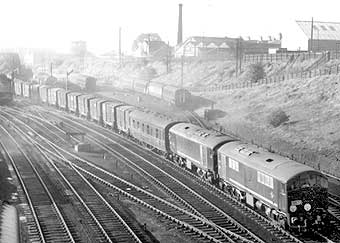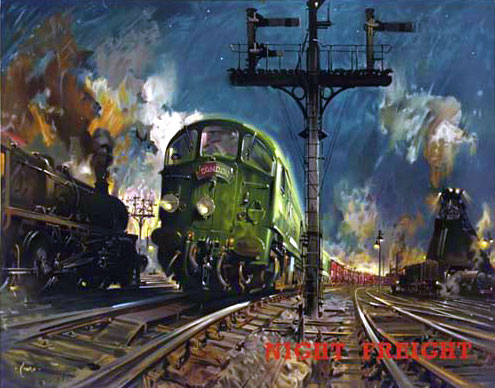 |
| A pair of Metrovicks with a dynamometer car work a pre-service 'Condor' test train through Wellingborough. (J. Pope) |
Trials commenced on July 7th 1958, when the doyen of the class, D5700, powered its 14 coach test train from Stockton-on-Tees to Leeds, encountering numerous problems along the way. After several unscheduled stops, it returned to the manufacturers - 90 minutes late!
Following rectification and further tests, a test train of the new 'Condor' service (the forerunner of today's Freightliner) was hauled on October 1st 1958 as D5700 & D5701 were attached to a train of 25 wagons, each carrying two small containers. The name 'Condor' was derived from "Container Door to Door" and the service was to commence the following Spring, offering guaranteed next day delivery between makeshift trans-shipment sheds at London's Hendon and Glasgow's Gushetfaulds goods depots. The service was to run via Leicester, Sheffield, Leeds & Carlisle.
 |
| A pair of Metrovicks with a dynamometer car work a pre-service 'Condor' test train through Wellingborough. (J. Pope) |
Following petrol rationing in 1956 as a result of the Suez crisis, traffic was forced back onto the railways from the road hauliers. BR had the perfect opportunity to demonstrate that it could compete with road transport and could provide a modern, fast freight service. By mid 1957, traffic was already slipping back to the roads and by the time "Condor" was actually launched on March 16th 1959, it was two years too late. The 'Condor' was launched as a 27 wagon train grossing about 550 tons fully loaded, stipulating a rostered pair of Co-Bos. Regulations specified that if one of the pair was found to be defective on shed, the train was to be steam hauled by a pair of Stanier "Black 5" 4-6-0s; but if one of the diesels failed en-route, it was okay to leave the other one in place and couple a steam locomotive inside it to replace the failed diesel! It was soon realised, however, that the 'Condor' service could not sustain a 27 wagon loading and its formation was virtually halved by the Autumn - well within the capability of a single unit.
 |
|
|
The northbound 'Condor' was timetabled to leave Hendon at 19.23 and the first stage of the journey was the longest non-stop run scheduled for any passenger or freight train at the time - 301 miles to Carlisle Citadel station where there was a booked two minute stop for a crew change in the small hours of the morning. The diesel locomotives would not normally be changed, powering the train for its entire 402.5 miles, due to arrive at its destination by 05.20 (an average speed of 40mph!). This was also the longest locomotive through run in its day.
On Friday and Saturday nights when the 'Condor' did not run, the pair of Co-Bos stranded in Scotland after the Thursday night working were booked to work the 10.25 Glasgow Central - London Euston sleeper to Carlisle and the 21.25 Euston - Glasgow sleeper back again. Originally, the Co-Bos were expected to put in a lot more graft whilst in Scotland - to fulfil, in fact, some of the most intensive diesel locomotive rosters contemplated at that early stage of BR dieselisation, adding about 1750 weekly miles of daylight Scottish workings to supplement their night-time 'Condor' workings.
From the start, the Co-Bos were manned by specially trained Greenock crews working to Gourock and Wemyss Bay on short haul passenger trains, with appearances on the Cathcart Outer Circle trips not uncommon.
But all too soon, the Crossley diesel engines began to falter and the supervisors were too concerned to keep the Co-Bos mechanically fit for the 'Condor' job to assign them to regular daytime work.
From the start, the entire class was officially allocated to Derby (17A) but six members of the class were outstationed at Cricklewood on a rota basis for the double-headed 'Condor' workings, supplemented by working in singles on Bedford - Luton - Moorgate outer suburban passenger diagrams.
An experiment in March 1960 led to D5700 working a Cricklewood - Southern Region transfer freight but was abruptly terminated when the Co-Bo over-ran signals, allegedly due to inadequate braking power, leading to a derailment.
Upto this time, the class was also allocated to work (mainly in singles) the London St.Pancras to Manchester Central passenger expresses, sharing the workload with Jubilee and Black 5 4-6-0s, though as 1959 proceeded, it became commonplace to to see a Co-Bo and a 4-6-0 working in tandem!
After the brief sojurn handling the exresses over the Derbyshire Peak District and the 'Condor' express freights, the Class suffered from poor mechanical reliability and tales of fireballs shooting from the exhaust ports were commanplace and even the engines sheering off their mounting bolts was not uncommon! This is all the more extraordinary when it is realised that maximum speed of the Crossley diesel engines were amongst the slowest of the entire mainline diesel fleet - 625rpm instead of the 750 to 850rpm range that was typical of many other classes of locomotive. There were of course special cases like the Deltics and diesel-hydraulics which had high speed diesel engines. Indeed, the Maybach power unit of a Western 'D1000' Class's idling speed was almost as fast as a Metro-Vick's top speed!
By early 1960, the Class, having suffered frequent mechanical failures, and just 3 of the original 20 were available for traffic. This was partly as a result of the steeply graded inclines along the routes they worked. The locomotives were frequently stopped at Ais Gill, Grayrigg, Shap and Beattock.
With upto 17 of the Co-Bos awaiting attention at Derby and Cricklewood depots at one time in 1960, many were declared stored unserviceable whilst BR and the manufacturers were locked in argument over who should pay to make the machines more reliable. Steam power temporarily took over the Condor service and its reliability improved. This was maintained when the service was taken over by Derby built Type 2s (D5000 series) in 1961.
The stored examples spent the winter of 1960/61 in store at Trafford Park shed until the Co-Bos were duly returned to Metropolitan Vickers' works at Dukinfield, Manchester to receive modifications and a general overhaul. The midland operators were not unduly put out by the loss as deliveries of the Derby built Type 2s and Type 4s were proceeding apace and the operating departments were much at ease with their new Sulzer engined charges. By mid 1961, just two examples were available for traffic!
Once BR and the locomotive builders eventually agreed on the necessary course of action (and who should foot the bill!), D5707 and D5713 were first to enter Metropolitan Vickers' works and the rest followed two at a time. The problems all centred around the Crossley diesel engines which let down the locomotives although they were on the whole quite well built, unlike some of the Pilot Scheme locomotives such as the disastrous North British built examples. These suffered from shoddy workmanship as the factory turned its hand to diesel locomotive construction after virtually a lifetime of purely steam locomotive construction, much of it for export.
Whilst undergoing their heavy repairs, another source of annoyance was cured - the wraparound cab windows. Whilst these looked quite stylish and offered good forward views for the traincrew, they were susceptible to dropping out a high speed due to vibration! Bearing in mind that the maximum service speed of the Co-Bos was a relatively modest 75mph, this was quite a feat! This design fault necessitated the wraparound window frames to have new window frames welded inside the originals and a more robust rubber seal installed to hold the now flat window glass in place, a feature clearly visible on D5705.
After overhaul, the locomotives were not returned to Derby as expected, but were dispatched en-masse to Furness and West Cumberland where they spent the rest of their service lives pottering about the Cumbrian Coast and Lake District branch lines. The first examples trickled through in early 1962 and the remainder followed by the end of the year. Although all allocated to Barrow-in-Furness shed, a few were sub-shedded at Workington, the train crews and fitters seeming to know how to get the best out of them. Indeed, one Barrow driver was known to claim that the refurbished class were just as reliable as any other diesel type on the London Midland Region, opining that the Midland men just didn't know how to handle them.
Apart from workings confined to the area around their new homes, other regular workings were the Heysham Moss - Whitehaven Fina petrol train, which included upto 25 wagons at a time and Sellafield construction traffic. There were two unusual forays into strange territory. Remembering the cross-London freight fiasco, it seems odd that in May 1963, a member of the class was found superior to an English Electric Type 4 (D200 series) in braking power as motive power for the unit trains of ICI bogie limestone hoppers between Tunstead quarry near Buxton, Derbyshire and Northwich in Cheshire. Then, in March 1965, D5708 and D5717 inexpliccably turned up in London for further trials on inter-regional freight workings. They were to work in singles between Willesden and Feltham or Nine Elms, and between Feltham and Ripple Lane but this trial ended after just a few days without any follow ups.
By 1965, BR pondered the pros and cons of giving the Co-Bos a new lease of life by re-engining them in a similar way to the Brush Type 2s, their troublesome Mirlees power units being replaced by English Electric ones. Again, this was not followed up and the class limped along for a further couple of years with various class members falling by the wayside into store.
It came as no surprise then, that in 1968, the class figured in BR's first programme of main-line diesel withdrawals, being condemned as 'non-standard' before the steam engines that they were designed to replace had even vanished. But this was not before D5701 gave us a tantilising glimpse of what might have been. This machine was the sole example to be painted in BR blue with full yellow ends - a livery that the locomotive design wasn't really suited to!
Astonishingly, the Class was not condemned to extinction. Courtesy of the Railway Technical Centre in Derby, there was to be a strange twist in the fascinating history of these locomotives.
With regards to D5705, Glen Hopkin reports that this particluar machine was delivered new to Derby on 6th December 1958. The locomotive was stored from February 1961 until February 1962 at Cricklewood, North London and then transferred to Barrow. In December 1966 she was transferred to the depot at Carlisle Upperby and went to Crewe works for a modified engine in April 1967. Her final transfer was to the new Diesel depot at Carlisle Kingmoor in February 1968. D5705 was withdrawn from capital stock on 7th September 1968. The locomotive was commandeered by the Research Centre at Derby and re-numbered S15705. she was used to haul various test trains around the system. In January 1975 the loco was again renumbered to TDB 968006 and was used as an static train heating unit in South Wales and Bristol, arriving here in February 1976. In June 1980 the locomotive was moved to Swindon Works for storage following the purchase into preservation. She was stored in the Civil Engineering Siding at Swindon until being resold and moved to Peak Rail Site at Matlock on the 20th March 1986. The final move to the East Lancashire Railway at Bury was by road in January 1997.